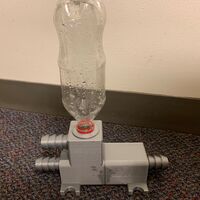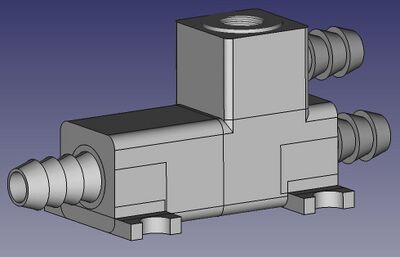| Line 59: | Line 59: | ||
==References== | ==References== | ||
<ref> web page: Bernoulli's principle, Available: https://en.wikipedia.org/wiki/Bernoulli%27s_principle</ref> | |||
<references/> | <references/> | ||
Revision as of 20:59, 4 December 2019
Ram Pump
Project developed by nkbuday (Nick Buday)
Template:Statusboxtop Template:Status-design Template:Status-prototype You can help Appropedia by contributing to the next step in this OSAT's status. Template:Boxbottom
Abstract
- This OSAT project is the design and prototyping of a hydraulic ram pump. This pump features no motorized parts and can be left unattended for extended duration with minimal upkeep. This pump is designed to allow someone in an area with hills with a water source far away. The ram pump does have a lot of waste water compared to how much it pumps, so it is ideal to place the waste outlet into a natural occurring water source.

Bill of Materials
- Standard Pop Bottle (~$2 USD)
- Super Glue (~$5 USD)
- Knife or cutting edge to clean up print if need be
- 3D Printed Parts
Tools needed for fabrication of the OSAT
- MOST Delta RepRap or similar RepRap 3-D printer
- Knife
Skills and Knowledge Necessary to Make the OSAT
- [Science behind pump]
- No special skills or knowledge needed to assemble pump
Technical Specifications and Assembly Instructions
- [Ram Pump Assembly]
- Print time ~~18 hours
- Assembly time ~~30 min

Common Problems and Solutions
- To avoid trouble with assembly, use the knife to smooth the parts till they fit "snug".
- Highly recommended to print the adapters and restrictions at layer height of 0.3 mm
- Highly recommended to print the pump bodies at layer height of 0.2 mm
- Highly recommended to print the threads at layer height of 0.1 mm
- When using super glue, be careful not to overdue it. Too much glue can clog areas of the pump. Just keep a towel or rag handy to wipe excess glue in some areas.
- If the pump is struggling to pump water, make sure the source for the inlet is significantly higher than the pump (at least 1 meter)
Cost savings
- Material Costs total ~~$13.8 USD
- Printinf cost ~~$6.8 USD
- Resources cost ~~$7 USD
- Commercial 1" Ram Pump ~~$165 USD[1]
- Savings
- ~~$151.2 USD in savings
- ~~ 91% in savings
Benefited Internet Communities
References
- ↑ web page: Bernoulli's principle, Available: https://en.wikipedia.org/wiki/Bernoulli%27s_principle
Based on the developmental needs addressed (e.g. food, heat, electricity, clean water, health care, etc.) be sure to label your device in the proper categories e.g. use [[Category:Water]]. Be sure to categorize your device so that it will be easy to find – for example “Low voltage connection basics” is categorized in [[Category:How tos]] [[Category:Electricity]] [[Category:Electric lighting]].